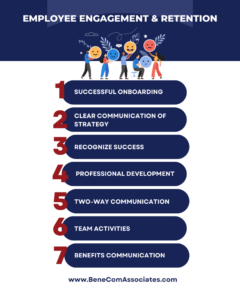Employee retention refers to an organization’s ability to retain its employees. Employees leave organizations for a number of reasons, including inadequate training, better pay or benefits elsewhere, poor leadership, and lack of flexibility, among other reasons.
A great first step to measuring and accessing employee retention is to calculate your employee retention rates. This can cover any time period from one year to five years, depending on your organizational goals. After deciding on the time period, take the number of employees who stayed divided by the number of employees in the initial snapshot and multiply your result by 100 to get your retention as a percentage. For example, if you started the year with 100 employees and only 64 of those same employees work for your organization at the end of the year, your 1-year retention rate is 64%.
When great employees leave their employer, it leaves a costly and detrimental gap. Not only does the company have to foot the bill for recruitment and hiring costs, but they also have to fill the void during the interim, manage client relationships, and adjust assignments to accommodate the loss in employee experience and expertise. Additionally, there are employee turnover costs associated with training a new hire that might include labor, certification costs, and more. Perhaps most importantly, the organization loses valuable knowledge and expertise when long-term employees choose to exit.
When organizations understand not only why employees leave, but also why employees stay, they’re able to develop an employee engagement strategy that has a positive impact on the workforce, drives employee retention, and keeps top talent within their organization.

Employee engagement has been defined in many ways by different experts and thought leaders, but the simplest definition is this: an employee’s level of emotional commitment to their company and their work. Engagement goes beyond job satisfaction and speaks to the worker’s interest in contributing, being a part of something greater than themselves, and staying. An engaged employee is most likely to demonstrate a high level of productivity, deliver quality results, work safely, and engage positively with colleagues and customers.
The factors that influence and boost employee engagement and retention are often the same. Employees are most engaged when they have great leaders, autonomy to perform their work in the way that makes the most sense for them, a caring company culture, work that’s meaningful, opportunities for growth, frequent recognition and feedback, an inclusive work environment, and competitive pay and benefits.
If even one factor is missing, disengagement can start to brew. For example, if an employee has great leadership and opportunity for growth, but their pay and benefits package doesn’t allow them to care for their family, they’re likely to begin disengaging from their work. Likewise, great pay and benefits don’t make up for poor leadership or lack of recognition and feedback. Signs of low employee engagement include low employee engagement scores, doing the bare minimum, and “quiet quitting”.
Employee morale and engagement are critical in supporting strategic initiatives. Improving quality, productivity, safety, customer satisfaction, or retention can only be achieved with an engaged workforce. When employees understand and connect with the company’s values and strategy, they’re not only willing but eager to use their talents to further that strategy.

Engagement and retention are innately intertwined across all workplaces and all industries. More specifically, employees who are emotionally committed to the company they work for are more likely to stay with their employer, even if offered another position elsewhere. In a nutshell, this cause-effect relationship indicates that when employers invest in engagement, they get both engagement and retention as outcomes.
HR leaders are often identified as the “owners” of engagement and retention, but companies that do this right know there are many key players: frontline managers, HR professionals, brokers, other execs, employees, and business owners all play a role.

Just like we make immediate judgments about people we meet, new employees make decisions about their employer their first day on the job. A successful onboarding process helps a new hire connect with the mission, vision, and values, feel welcome and included, and understand how their role fits into the company’s overall objectives can improve that first impression, increasing engagement and likelihood of staying.
A successful onboarding:
Employees who know how their role fits into the organization and how their efforts contribute to the success of the company are more likely to be emotionally committed to their work and their organization. Furthermore, workers who know exactly what’s expected of them are able to deliver according to those expectations.
When leaders transparently share their vision and strategy, their team members can make decisions and do work that contributes to the achievement of those goals.
While juggling operations, financials, and people, leaders often forget to recognize and celebrate successes. However, recognizing employee wins contributes to their commitment to your organization and team and makes it more likely that they’ll stay with your company for a long time. Simple ways to recognize success include sending a quick team email to call out a big win, celebrating work anniversaries with years of service awards and celebrations, and calling out accomplishments during team meetings.
Celebrating successes also makes it easier to address performance issues and skills gaps when they arise as employees feel confident, secure, and more open to feedback.
While some workers have aspirations of growing into leadership positions, others simply want to do their best work in their current roles. Both groups require professional development in order to refine their skills and better prepare themselves for what’s next for them – whether it’s an assignment, a promotion, or a new challenge.
Leaders can help by visiting with employees about their career goals during routine conversations, sharing professional development opportunities as they arise, and helping employees envision themselves in new roles, assignments, or projects and prepare accordingly.
It’s a common misconception that feedback is difficult for employees. In many cases, employees crave honest feedback that will empower them to be successful and meet expectations, but sharing that insight can be difficult for leaders.
A healthy organization with high engagement and retention offers courageous, two-way communication. Leaders not only openly share expectations and opportunities with their team members but respond receptively when employees share feedback with them.
Research shows that having a friend at work is positively correlated with positive business outcomes, and establishing friendship is easier when there are opportunities for connection, socialization, and team-building. Team activities can help colleagues get to know one another on a personal level, build trust, and laugh at work – all of which are key to engagement and retention.
Providing employees with the tools and resources they need to achieve a healthy work-life balance is key to a trusting relationship, which leads to improved employee satisfaction. Perhaps most important among these tools and resources is a competitive benefits package that makes caring for their physical and mental health – and their family members’ physical and mental health – both accessible and affordable.
While research varies, multiple studies confirm that a significant percentage of many workforces don’t understand their benefits. They may not know which benefits are available to them, what they are enrolled in, how to access benefits when they need them, or how those benefit plans will cover their expenses. When your people can’t access their benefits, they can’t take care of themselves and their families – leading to stress, absenteeism, accidents, and disengagement. Improved understanding and access can lower absenteeism and reduce turnover rates.
Investing in benefit plans that meet the needs of your people is the first step, but the next step is communicating those benefit offerings in a way your employees can understand and providing them with quick, easy access to their benefits when they need them.
Benefits communication should be done on a regular basis, not just at open enrollment. Common channels include newsletters, social media, and print media. Creating a benefits communication calendar can help you remember the importance of communicating year-round and not just as open enrollment nears or closes.
Engagement and retention go hand in hand. A key step toward employee engagement and staff retention is strengthening your company’s employee benefits communication strategy using a partner like BeneCom.

Partnering with a reliable, effective benefits communication agency like BeneCom Associates is key. BeneCom allows you to improve communication and support of your employees without overburdening your human resources department.
At BeneCom Associates, we feel passionate about communicating benefits in unique, interactive ways. We offer customized communication solutions to ensure that your company meets its benefits objective on time and stays within budget for the entire year. BeneCom understands that few HR teams or department managers have the time to micromanage the entire employee benefits process. Fortunately, that is our expertise, as we have created successful communications projects for over 30 years. We provide these communication solutions to a variety of companies from small family-owned businesses to Fortune 500 organizations:
Learn more today by giving us a call or filling out our online form. Engagement and retention are just a phone call away.